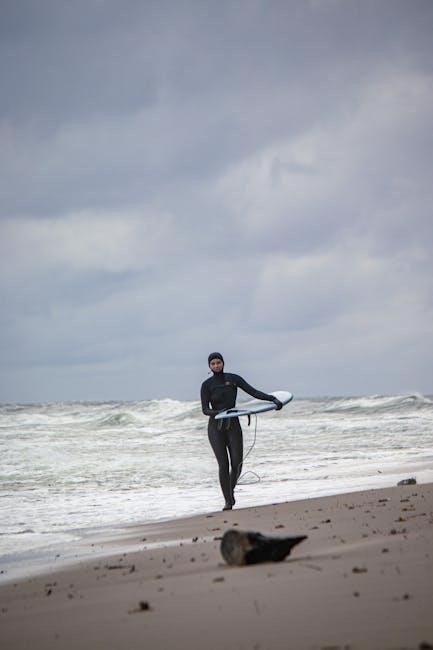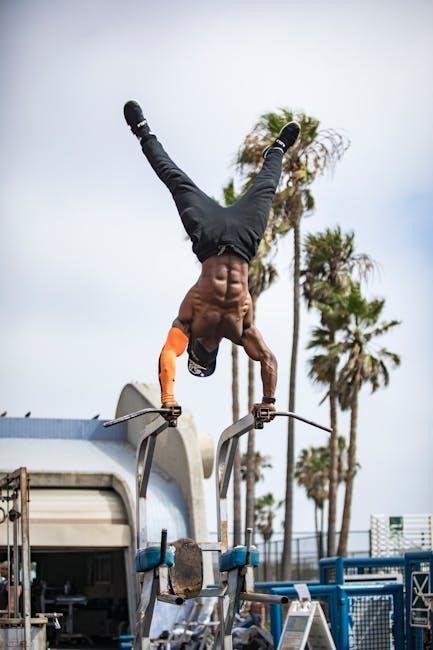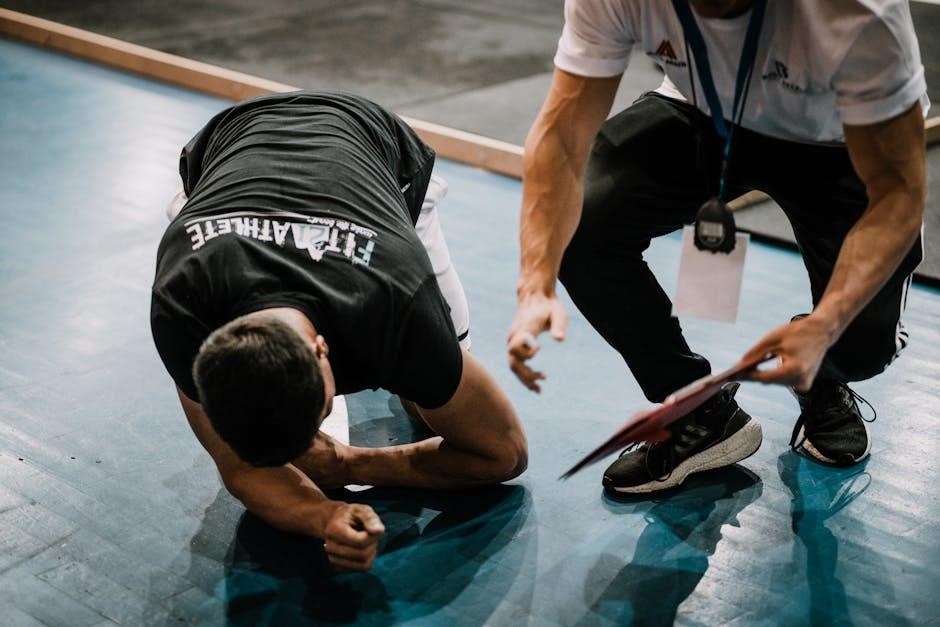A well-structured triathlon strength training program enhances endurance, power, and overall performance by targeting lower body, core, and upper body muscles. It includes exercises like squats, deadlifts, and step-ups, with a focus on periodization and progressive overload to prevent injury and improve efficiency. Proper technique and nutrition, such as adequate protein intake, are crucial for optimal results.
1.1 Importance of Strength Training for Triathletes
Strength training is essential for triathletes to enhance endurance, power, and overall performance. It improves muscular stability, reducing the risk of injury and boosting efficiency in swimming, cycling, and running. By targeting key muscle groups, triathletes can maintain proper form and generate more force, leading to faster times and better resilience during long-distance events. Incorporating exercises like squats, deadlifts, and step-ups strengthens the lower body, while core and upper body workouts enhance stability and propulsion. A well-structured program also addresses imbalances, ensuring balanced development across all muscle groups. This foundation of strength allows triathletes to handle the demands of training and competition more effectively, ultimately improving overall race performance and longevity in the sport.
1.2 Overview of a Triathlon Strength Training Program
A triathlon strength training program is designed to improve endurance, power, and overall athletic performance. It typically includes a mix of lower body, core, and upper body exercises such as squats, deadlifts, step-ups, and bench presses. The program is structured to address specific muscle groups, ensuring balanced development and injury prevention. Key components include periodization, where training intensity and volume vary across phases, and progressive overload, gradually increasing weights or reps to build strength. Functional exercises like single-leg squats and glute bridges are also incorporated to enhance stability and mobility. The program is tailored to complement swim, bike, and run training, ensuring triathletes can maintain proper form and generate maximum efficiency during competitions. A well-designed program also considers recovery and nutrition to support muscle growth and overall performance.

Components of a Triathlon Strength Training Program
A triathlon strength program includes lower body exercises like squats and deadlifts, core workouts, upper body exercises like bench presses, and functional movements to enhance overall athleticism and endurance.
2.1 Lower Body Strength Exercises

Lower body strength exercises are foundational for triathletes, enhancing running and cycling efficiency. Essential exercises include squats, deadlifts, step-ups, and Bulgarian split squats, which target the quads, hamstrings, glutes, and calves. These movements improve power, endurance, and stability. Leg press and hip thrusts are also effective for building strength in the lower body. Single-leg exercises, like single-leg squats and step-ups, are crucial for addressing imbalances and improving balance. Varying exercises every few workouts ensures comprehensive development. Proper form and progressive overload are key to maximizing benefits and preventing injury. Incorporating these exercises into a structured program enhances overall triathlon performance by boosting speed, endurance, and resilience in the lower body.
2.2 Core Strength Exercises
Core strength is vital for triathletes, as it enhances stability, endurance, and overall performance. Key exercises include planks, side planks, and bird dogs, which target the abdominals and obliques. Russian twists and leg raises also improve core stability and rotational power. Incorporating glute bridges and dorsal raises strengthens the posterior chain, essential for running and cycling. These exercises help maintain proper form during long races, reducing the risk of injury. A strong core improves transitions between swimming, cycling, and running, making it a cornerstone of any triathlon strength training program. Consistency and proper technique are key to maximizing benefits and achieving peak performance.
2.3 Upper Body Strength Exercises
Upper body strength is essential for triathletes to enhance swimming, cycling, and overall endurance. Key exercises include bench press, shoulder press, and incline press-ups, which target the chest, shoulders, and triceps. Lateral raises and front raises improve shoulder stability, crucial for swimming and handling the bike. Incorporating lat pulldowns and rows strengthens the back muscles, aiding in maintaining proper posture during cycling and running. These exercises also help prevent shoulder injuries common in triathlon training. Consistency and proper form are vital to maximize benefits. A well-rounded upper body program complements lower body and core training, ensuring overall strength and endurance for peak performance in triathlon events.
2.4 Functional Strength Exercises
Functional strength exercises are designed to improve coordination, balance, and overall athletic performance. For triathletes, these exercises often include single-leg squats, step-ups, and Bulgarian split squats, which enhance stability and running efficiency. Glute bridges and hip hikes strengthen the posterior chain, crucial for cycling and running. These movements mimic real-world athletic actions, making them highly transferable to triathlon events. Incorporating functional exercises ensures that strength gains are practical and sport-specific, reducing the risk of injury and improving overall performance. Varying exercises every few workouts keeps the training dynamic and prevents plateaus, ensuring continuous progress in strength and endurance.

Training Principles for Triathlon Strength Training
Periodization and progressive overload are foundational, ensuring gradual strength gains. Varying exercises every few workouts keeps training dynamic, preventing plateaus and enhancing endurance and power.
3.1 Periodization of Strength Training
Periodization in triathlon strength training involves structuring workouts into specific phases to optimize performance. It typically includes a base-building phase focusing on endurance and foundational strength, followed by a build phase that introduces more intense exercises like squats and deadlifts. The competition phase emphasizes functional strength and power, aligning with the triathlon season. This structured approach prevents overtraining and ensures peak performance during races. By varying exercises and intensity, periodization keeps the training dynamic and effective, helping triathletes build resilience and avoid plateaus.
3.2 Progressive Overload in Strength Training
Progressive overload is a cornerstone of effective strength training, involving gradual increases in intensity to challenge muscles and drive adaptation. For triathletes, this can mean adding weight, reps, or reducing rest between sets. Exercises like squats and deadlifts benefit from this approach, as they build foundational strength. Varying exercises, such as switching from traditional squats to Bulgarian split squats, also applies progressive overload. Consistency and patience are key, as gradual increases prevent injury and ensure sustained progress. Incorporating this principle helps triathletes enhance endurance, power, and overall performance, making it a vital component of a structured training program.
Sample Weekly Training Plan

A structured plan includes four days of strength training: lower body, core, upper body, and functional strength, with rest days for recovery and mobility work.
4.1 Day 1: Lower Body Focus
Day 1 focuses on building strength in the legs and hips, essential for cycling and running. Start with a dynamic warm-up, then perform exercises like squats, deadlifts, and step-ups. Include 3-4 sets of 8-12 reps for each exercise, ensuring proper form. Add calf raises to target smaller muscle groups. Finish with a cool-down and stretching to improve mobility. This routine enhances power and endurance, reducing injury risk. Consistency and progressive overload are key for continuous improvement. Proper nutrition and recovery support muscle growth and overall performance. This structured approach ensures triathletes build the necessary strength for their sport.

4.2 Day 2: Core and Upper Body Focus
Day 2 emphasizes building core stability and upper body strength, crucial for swimming and cycling. Begin with a dynamic warm-up, then perform exercises like bench press, shoulder press, and lat exercises. Include 3-4 sets of 8-12 reps for each exercise, focusing on proper form. Core workouts such as planks, Russian twists, and leg raises are essential for improving stability. Finish with a cool-down and stretching to enhance flexibility. This routine strengthens the muscles used in swimming and cycling, improving endurance and reducing injury risk. Consistency and progressive overload are key for continuous improvement. Proper nutrition and recovery support muscle growth and overall performance. This structured approach ensures triathletes build the necessary strength for their sport.
4.3 Day 3: Functional Strength and Mobility
Day 3 focuses on functional strength and mobility to enhance triathlon-specific movements. Begin with a dynamic warm-up, including exercises like single-leg squats and step-ups to improve balance and stability. Incorporate mobility drills for hips, shoulders, and ankles to reduce stiffness and prevent injuries. Use resistance bands or light weights for exercises like lateral raises and bird dogs to strengthen smaller muscle groups. Include core-strengthening movements such as planks and side planks. Finish with a cool-down, including stretching and foam rolling to improve recovery. This day emphasizes functional movements that mimic triathlon activities, ensuring better efficiency in swimming, cycling, and running. Proper technique and consistency are key to maximizing benefits and reducing injury risk. This balanced approach supports overall performance and longevity in training.

Exercise Instruction and Technique
Proper form and technique are crucial for effective strength training. Focus on exercises like squats, deadlifts, and lunges, ensuring full range of motion to prevent injuries and enhance performance.
5.1 Squats and Variations
Squats are a fundamental exercise in triathlon strength training, targeting the legs, glutes, and core. Proper form involves keeping the chest upright, engaging the core, and lowering the body until the thighs are parallel to the ground. Variations like single-leg squats improve balance and stability, while box squats help build explosive power. Incorporating these exercises strengthens the muscles used in running and cycling, enhancing endurance and efficiency. Consistency and proper technique are key to maximizing benefits and preventing injury. Regular practice ensures improved performance in all three triathlon disciplines.
5.2 Deadlifts and Variations
Deadlifts are a powerful exercise for triathletes, targeting the posterior chain, including the hamstrings, glutes, and lower back. They improve running and cycling efficiency by strengthening these critical muscle groups. Variations like the trap bar deadlift reduce strain on the lower back, while Romanian deadlifts focus on the hamstrings. Single-leg deadlifts enhance balance and stability, mimicking the single-leg phase of running. Proper form is essential to avoid injury, with a focus on maintaining a neutral spine and engaging the core. Deadlifts should be incorporated into strength training routines to build overall lower body strength and endurance, directly benefiting triathlon performance. Consistent practice with progressive overload ensures continuous improvement in power and stamina.
5.3 Lunges and Step-Ups
Lunges and step-ups are essential for triathletes, enhancing lower body strength, balance, and endurance. Forward lunges and reverse lunges target the quads, hamstrings, and glutes, improving running efficiency. Step-ups strengthen the legs and hips, mimicking the single-leg phase of running. Variations like Bulgarian split squats and single-leg step-ups enhance stability and reduce injury risk. Proper form is critical, with a focus on maintaining a neutral spine and engaging the core. Lunges and step-ups should be performed with controlled movements, using dumbbells or a barbell for added resistance. Incorporating these exercises into a weekly routine helps build functional strength, directly benefiting triathlon performance by improving power and endurance during cycling and running segments. Consistent practice ensures continuous progress in overall lower body stability and race readiness.
Injury Prevention and Recovery

Proper recovery and injury prevention are vital for triathletes. Techniques include stretching, foam rolling, and adequate rest. Strengthening core and key muscle groups reduces injury risk and enhances recovery.
6.1 Common Injuries in Triathlon Training
Triathletes often face injuries due to repetitive stress and overuse. Common issues include runner’s knee, IT band syndrome, shin splints, and lower back pain. These injuries frequently arise from overtraining, poor form, or muscle imbalances. Strengthening exercises, proper technique, and adequate recovery can help mitigate these risks. For example, weak core muscles often contribute to lower back pain, while poor running mechanics can lead to knee and shin issues. Addressing these factors through targeted strength training and flexibility work is essential for long-term injury prevention and sustained performance in triathlon events.
6.2 Recovery Techniques for Strength Training
Effective recovery is crucial for triathletes to optimize strength training benefits and prevent overtraining. Techniques include foam rolling, stretching, and compression garments to improve blood flow and reduce muscle soreness. Active recovery, such as light swimming or cycling, promotes circulation without excessive strain. Additionally, nutrition plays a key role, with adequate protein intake supporting muscle repair. Rest and sleep are also vital, as they allow the body to rebuild and adapt. Incorporating these methods into a routine helps maintain consistency and enhances overall performance in triathlon training. Proper recovery strategies ensure athletes can sustain their strength and endurance programs without injury or burnout.

Nutrition and Supplementation for Strength Training
Nutrition is vital for triathlon strength training, fueling workouts and aiding recovery. A balanced diet rich in carbohydrates, proteins, and healthy fats supports muscle repair and energy. Proper hydration and supplements like protein powder or creatine can enhance performance and recovery, ensuring athletes meet their training demands effectively.
7.1 Importance of Protein Intake
Protein intake is essential for triathletes, as it supports muscle repair, growth, and recovery. Adequate protein helps build and maintain muscle mass, which is critical for endurance and strength. Triathletes require 1.2–2.2 grams of protein per kilogram of body weight daily, depending on training intensity. Sources like lean meats, fish, eggs, dairy, and plant-based options are ideal. Timing is also key, with post-workout protein consumption aiding recovery and reducing muscle soreness. Additionally, protein helps maintain immune function and overall health, preventing overtraining. Proper hydration and balanced nutrition, including carbohydrates and fats, complement protein intake for optimal performance. A well-planned diet ensures triathletes can handle the demands of their training and competitions effectively;
7.2 Role of Carbohydrates and Fats

Carbohydrates are the primary energy source for triathletes, fueling high-intensity workouts and endurance activities. They replenish glycogen stores, essential for sustained performance during races. Whole grains, fruits, and vegetables are ideal sources. Fats, particularly healthy fats, provide long-lasting energy, support hormone production, and aid in vitamin absorption. Avocados, nuts, and olive oil are excellent choices. Balancing carbohydrates and fats ensures optimal energy levels and supports overall health. During training, triathletes should aim for a diet rich in complex carbs and moderate in healthy fats to maintain performance and recovery. Proper timing of carb and fat intake around workouts can enhance endurance and reduce fatigue, making them indispensable in a triathlon strength training program.
7.3 Supplements for Recovery and Performance
Supplements play a crucial role in enhancing recovery and performance for triathletes. Protein shakes are essential for muscle repair and growth, while creatine boosts endurance and strength during high-intensity workouts. Branched-Chain Amino Acids (BCAAs) reduce muscle soreness and fatigue. Iron supplements support oxygen delivery to muscles, combating anemia. Electrolytes replenish lost salts, maintaining hydration and preventing cramps. Omega-3 fatty acids reduce inflammation, aiding recovery. Adaptogens like ashwagandha help manage stress and improve adaptation. These supplements, when combined with a balanced diet, optimize performance and recovery. Consistency and proper timing are key to maximizing benefits. Always consult a professional to tailor supplementation to individual needs and avoid overuse.
A well-structured triathlon strength training program enhances performance, prevents injuries, and boosts overall endurance. Consistency, patience, and proper form are key to achieving long-term success and peak conditioning.
8.1 Summary of Key Points
A triathlon strength training program is essential for improving endurance, power, and overall performance. It focuses on lower body, core, and upper body exercises like squats, deadlifts, and step-ups. Periodization and progressive overload are key principles to avoid injury and enhance efficiency. Proper technique, nutrition, and recovery are critical for success. Including single-leg exercises every few workouts ensures balanced strength. A structured plan with varied exercises, such as single-leg squats and hip hikes, helps build functional strength. Adequate protein intake supports muscle repair and growth. Consistency and patience are vital for achieving long-term benefits and peak conditioning in triathlon training.
8.2 Final Tips for Implementing a Strength Training Program
Consistency and patience are key to a successful triathlon strength training program. Always start with proper technique and gradually increase intensity. Incorporate single-leg exercises every few workouts to prevent imbalances. Vary exercises regularly to keep the program engaging and effective. Focus on functional movements that mimic triathlon-specific actions. Work with a coach or experienced trainer to ensure proper form and progression. Prioritize recovery techniques like stretching and foam rolling to avoid injury. Stay hydrated and fuel your body with adequate protein and nutrients to support muscle growth. Track your progress and adjust the program as needed. Remember, strength training is a long-term investment in your triathlon performance.


